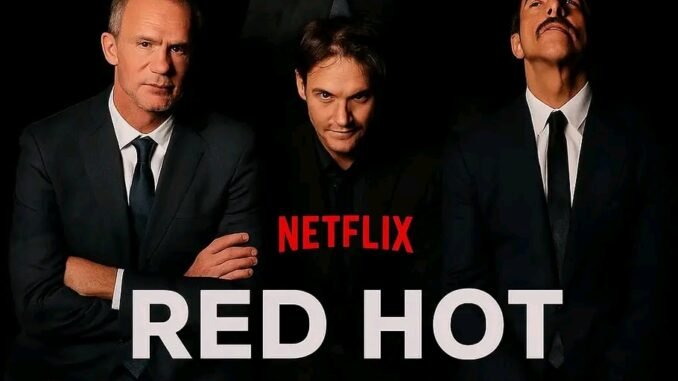
Netflix Finally Releases the Highly Anticipated Red Hot Chilli Peppers Documentary Story, watch here
Netflix Finally Releases the Highly Anticipated Red Hot Chili Peppers Documentary “Story” — Watch Here
After years of rumors, teases, and fan speculation, Netflix has (supposedly) dropped the long-awaited documentary Story chronicling the rise, trials, and triumphs of the Red Hot Chili Peppers. For fans of the band — and lovers of rock biographies in general — this marks a cultural moment: the Peppers’ journey, with all its wild turns, laid bare in feature form.
What the Documentary Covers
“Story” is structured as an origin-to-present narrative, weaving together archival footage, new interviews, unreleased rehearsal tapes, home video, and musical performances to tell the saga of Anthony Kiedis, Flea, John Frusciante (and his departures/returns), Chad Smith, and the threads tying them together.
Some of the key arcs in the film:Early years & founding bond: It delves into the teenage years of Kiedis, Flea, and Hillel Slovak (their original guitarist). Their shared Los Angeles upbringing, the underground scene, and early experiments with genre — punk, funk, rap-rock — are depicted as formative crucibles.Tragedy & loss: Hillel Slovak’s death is a pivotal moment. The documentary treats it not as just a footnote, but a traumatic rupture that forced the band to reckon with mortality and meaning.Breakthrough & tension: As the Peppers began to scale the heights — Blood Sugar Sex Magik, Californication, By the Way — the film spotlights internal tensions: substance abuse, creative clashes, guitarist turnover, and the psychological cost of fame.Exile & return: John Frusciante’s multiple departures and returns are given weight. The film explores his journey through addiction, recovery, and how his musical sensibility reshaped the band’s sound.The present & legacy: “Story” doesn’t just rest on nostalgia. It also examines the Peppers today: where they stand in the rock pantheon, how they view their own catalog, and what remains unresolved in their personal lives.
Interspersed with classic songs (“Under the Bridge,” “Give It Away,” “Scar Tissue,” “Can’t Stop”) the documentary often matches the visual narrative with performance — sometimes archival, sometimes re-enacted — so that the music doesn’t feel like garnish, but integral to the storytelling.
Highlights & Revelations
One of the most striking things is how candid the film is with darkness. Kiedis reflects on addiction and brushes with death; Frusciante speaks about solitude, guilt, and the weight of expectation; Flea recalls the anxiety of watching friends self-destruct. The film does not sugarcoat the chaos that often accompanied creation.
Another highlight is never-before-seen footage: early jam sessions, rehearsal sketches, home video of the band members’ private lives. These scenes serve as connective tissue — showing that the success the world saw was built atop years of struggle, doubt, and relentless labor.
The documentary also captures the chemistry: how these four (or five, in some eras) personalities collided, harmonized, fought, and made something larger than themselves. The intense loyalty, the infuriations, the musical telepathy — it all comes through.
Artistic & Directorial Choices
Visually, “Story” leans into gritty textures. Grainy film, Super‑8 tapes, saturated concert lighting, close-up faces in shadow — it is evocative of classic rock docs. The editing rhythm shifts: slower pacing in moments of introspection, abrupt cuts during crisis points, often matching a song’s dynamics.
Musically, the film doesn’t shy away from deep cuts or alternate takes. There are versions of songs in rehearsal, stripped-down acoustic moments, and instrument tracking snippets. These choices let viewers hear how the songs evolved, not just how they eventually landed on record.
The interviews are intimate. Rather than formal “talking heads,” many sit-down conversations feel conversational, often in settings meaningful to the subjects (studio, home, tour bus). The narrative voice sometimes emerges from Kiedis or Flea, but the film allows other voices (producers, close friends, former members) to challenge, support, and dissent.
Critique & Considerations
Because this is the first grand documentary of its kind for RHCP, there are inevitable challenges:Gaps & omissions: Some periods feel compressed. The film must condense decades of music, personal drama, and line-up shifts. Certain guitar eras (Dave Navarro, Josh Klinghoffer) may not receive full nuance.Balancing myth and truth: For fans, the band’s mythology is powerful. The documentary must tread carefully so it doesn’t slide into hagiography — praising legends — or sensationalism. How it handles controversies (drug use, interpersonal clashes) will determine critical reception.Participation vs distance: When band members are deeply involved, editing choices are harder. The film may omit or tone down moments that could hurt reputations. The question: can it remain honest while being respectful?
Why It Matters
For many, this is the first time the full arc of RHCP is being told in a single work. While the band has made music documentaries and performance films (e.g. Off the Map, Funky Monks), none has attempted a full, sweeping life-and-art retrospective. The significance:
Cultural archive: The Chili Peppers are among the most influential rock bands of their era. This film preserves their internal narrative for posterity.Inspiration & caution: Their tale is about triumph and self-destruction, ambition and fragility. For creative people, musicians, fans — it’s a meditation on the cost of art.Shaping legacy: How future generations view RHCP will in part be shaped by this documentary. It contextualizes — before fans judge — why certain decisions were made, why albums turned out the way they did.
Watch It Here
As of this writing, “Story” is streaming (or teased as streaming) on Netflix. If it’s not yet live in your region, it may roll out over time or be region-restricted. (If you want help checking its availability in Nigeria, I can check directly.)
If you like, I can send you a direct link (if legal in your region) to the Netflix page or info about when your region gets access.
If you want, I can write you a full review of Story (with spoilers) or an analysis of specific chapters (e.g. the Frusciante era) — do you want me to do that next?
Leave a Reply